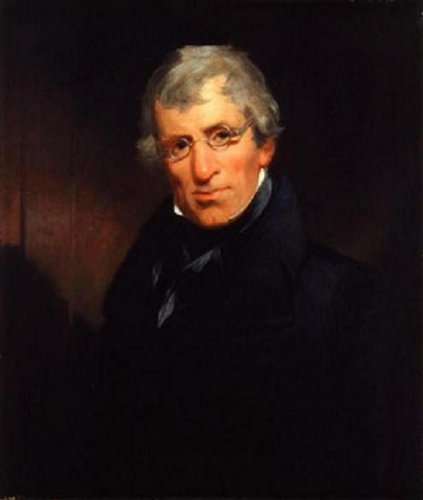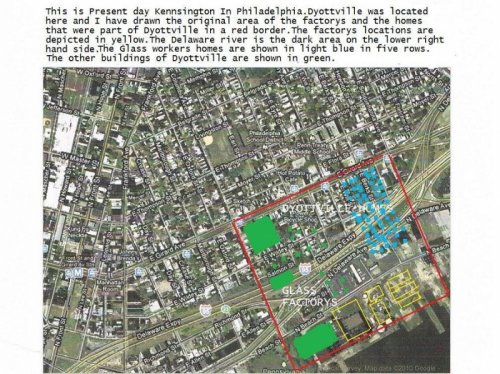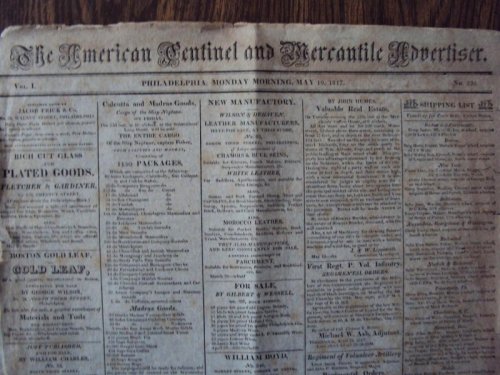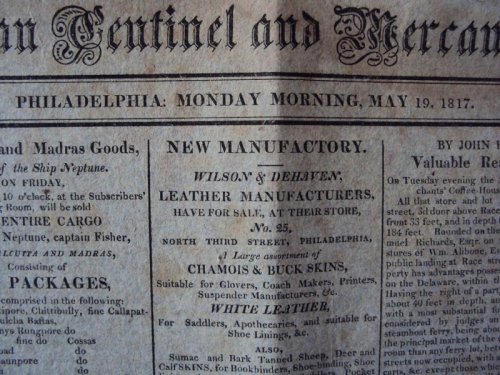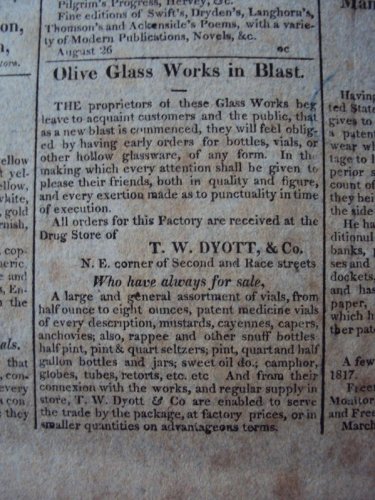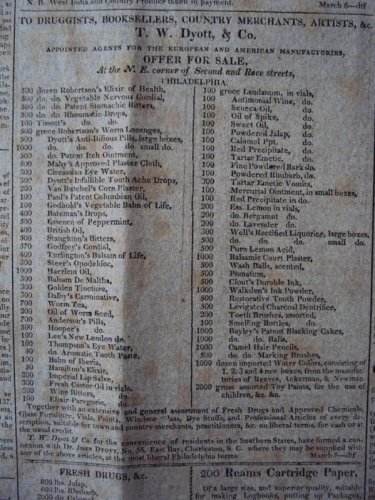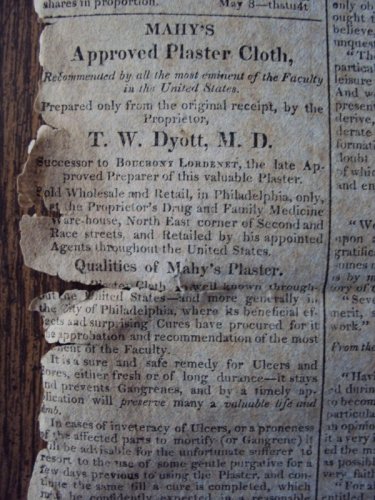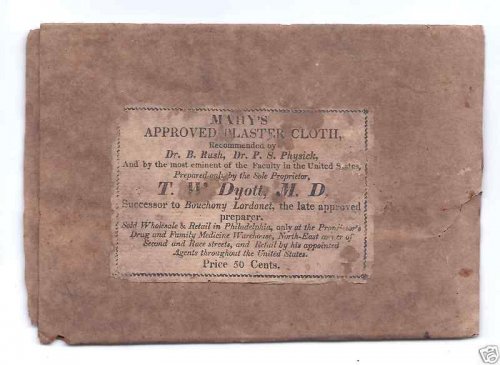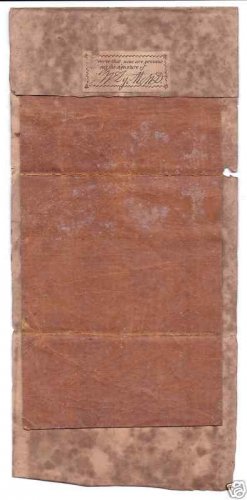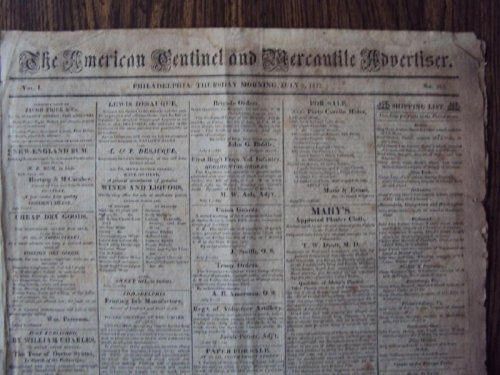Steve/sewell
Well-Known Member
- Joined
- Jan 23, 2010
- Messages
- 6,108
- Reaction score
- 5
- Points
- 0
Where do you start with a man like Dr.Thomas W.Dyott.No figure in the history of early American glass is more notorious or his wares more collectable than that of this man.His flasks were the first called by name in advertisments starting in 1821.
Thomas W. Dyott was born in 1777 in England (or possibly Scotland).He immigrated to Philadelphia around 1795 when he would have been 18 years old.Likely his travels took him from practicing medicine in Great Britan or at least working for a pharmacist there,on to the West Indies, and finally to Philadelphia.Thomas W. Dyott himself claimed to be the grandson of the celebrated Dr. Robertson of Edinburgh. Unfortunately, not only is there no evidence that he was Dr. Robertson’s grandson, but also there is no record of a Dr. Robertson practicing in Edinburgh during that time. The only other piece of information about Thomas W. Dyott’s life during this period is a statement made by one of his close friends,claiming that Dyott served an apprenticeship to an English druggist, who had taught him the art of making boot-blacking.He is arguably the most facsinating glass mogle there ever was.
By his own claim, he arrived in Philadelphia in 1805 nearly penniless.Soon thereafter, he set up a practice as a doctor and began selling medicines of his own invention. One of the stotries that has been tossed around about Dyott, was that when he arrived to America he had no money in his pocket.He then began concocting boot blacking at night, selling it by day and somehow established himself as a prominent business man in a matter of a few short years.Probably closer to the actual truth is that Thomas W. Dyott arrived in America with little money, but instead was carrying recipes of medicine formulas for which he was familiar with in Great Britain.Next he either began manufacturing his own medicines, which he sold to store Merchents,or,a more likely senario,he found a business with an existing manufactoror of medicines, who provided him with the facilities to begin the manufacture his own medicines.Once Thomas W. Dyott found customers for his medicine, he immediately began to advertise in the local newspapers and very soon after this he attached the word “Doctor†or “M.D.†to his name. Although there’s no formal record that he attended medical school,many doctors became such through apprenticeships with physicians or druggists. So calling himself a Doctor certainly added to his prestige and undoubtedly helped the sale of his drugs, doing so wasn’t considered an illegal or immoral act at the time.He was very oppurtunistic in his business approach and way ahead of the competion in regaurds to advertising his wares as he had over time 40 sales people in various parts of the United States with over 14 agents in the state of New York alone.
In order to keep pace with the demand for glassware, Dr.Dyott gained an interest in the Olive Glass Works in Glassboro, New Jersey. In 1817, still associated with Olive Glass Works,Dyott also became an agent for Gloucester Glass Works in Clementon, New Jersey and the Union Works at Port Elizabeth, New Jersey in 1818.These three factories allowed Dyott to gain almost complete control
of the glass,bottles and vials inventory in the Philadelphia region.Some of the bottles made here are famous English Patent medicines such as Turlingtons Balsam of Life,Godfreys Cordial,True Cephalick Snuff,Dalbys Carminitive and Essence Of Peppermint to name just a few.This arrangement lasted for four years until Dyott decided to purchase the old Kennsington Glass works late in the year of 1821.The Union and The Gloucester glass works soon closed after Dyott no longer needed their out puts
but the Olive Glassworks were consumed by the the Harmony Glass works which in a very short time became the famous Whitney Glass works and that is another story.
Dyott now had near complete control of the glass industry in the city of Philadelphia and in doing so made enemys of all the other glass factories in Southern New Jersey and as far away as New York and New England. The other factories had business dealers located in Philadelphia but were finding it quite difficult to compete with Dyott and petitoned Congress that Dyott had created a monopoly in the glass industry.But than the business climate in the new United States suffered a minor deppresion and before long Dyott had a host of creditors including David Wolf of the Olive Glass works that sizeable portions of funds were owed to.Dyott was forced into a court appointed trusteeship payout to his creditors but was finding it very difficult to make payments.Historians are unsure how Dyott pulled off the next sequence of events but he was able to pursuade the courts and his creditors that the only way he could colllect his debts was to allow him at the same time to run the glass factory again.To the amazment of his creditors and possibly Dyott himself he was able to pull himself out of financial ruin and actually turned a sizeable profit in 1826.The tariff act passed in 1828 helped fuel the recovery along even further.The late 1820s were Dyotts best business years as he continued to expand the size of and the number of his furnaces where he soon was employing over 150 men,boys and women.With three factories operating in 1828 and a fourth to come on line in 1829 Dyott had survived the tumultous 1820s and was ready to go another step in acheiving the best possible financial results.
In 1833 Dyott built the fifth and final glass factory and furnace.He had expanded the factorys land size from 1 and a half acres to six and a half acres.Late in the year 1832 Dyott named his factorys The Dyottville factorys.By the time the name Dyottville came into existence the village had unofficialy been an entity for two years already.In 1831 the news magazine Picture Of Philadelphia published that there were 5 factories,a mill house's for grinding clay and pot ashes,a clay house for melting the clay,Lime and sand house's for the storage of those ingredience's.A pounding house , a pot house,The superintendents house,Stablery for horse's,a wicker shop for Demijohn covering and other Basketry uses.There were 2 Smith shops where tools and blow pipes were made,A carpenters shop where the wooden crates were assembled,and any other lumber needs were satified.There was a firehouse located in the village,and there were 2 large warehouse type structures to store the glass products in.There were over 50 private brick dewellings for the workmen.The work force had now grown to 275 to 300 men and boys with another 30 women.The number of blowers was about 70 at this time the largest in the country.Also a wharf was in the process of being built with a hundred feet of frontage and extending 150 feet into the Delaware river.Not all was well for Dyott as the Glass manufactors of the Eastern United States were complaining to the Congress of the United States of Dyotts complete control of the Philadelphia market.Thomas Jefferson became involved on his friend Dr. Dyotts behalf when the Dr. founded his Dyottville temperance and closed society village and persuaded congress that it wasnt a complete monopoly but one that tried to correct an industry long strifed with alchohol abuse and social disfunction.In the end however Jefferson wrote that Dyott wouldnt want to be kept out of the New Jersey, New York and New England markets so he should honor the same of his counterparts from those regions .This along with the bank failures across the country in general really limited Dyotts ability to have complete control of the glass trade he so desired.
Even with all of the stumbling blocks placed in Dyotts business path Dyottville now was well established. Dyott turned to his business aquaintence Stephen Simpson.Simpson felt Dyott could enhance the factorys even further with the addition of first a newspaper and than a bank.Simpson asked Dr. Dyott was he a Democrat or a Whig to which Dyott replied neither,but Simpson explained to him he needed to choose a side.Simpson explained to Dyott that the Whigs had the most money but that the Democrats were the most numerous.Dyott chose to publish the newspaper with a Democratic slant.So begining on January 4th 1835 The Democratic Hearld and Champion of the People began its circulation.The publishers name on the newspaper was John Dyott Dr. Dyotts son.The paper lasted about two and a half years before becoming a victom of Dyotts second Business collapse.It was at this same time that Dyott became a banker after consulting with Simpson. Again he opened a savings fund bank with Simpson as his cashier and Peter Y. Calder as the teller on February 2nd 1836.Despite the lack of securing a bank charter from the Pennsylvania legislature Dyott In the month of May of the same year had savings deposits of 13,000 and officially opened the Manul Labor Bank at the N. East corner of Second and Race streets which replaced the Drug warehouse which moved next door to 139 Second street. The solvency of the Manul Labor Bank was looking good in the first two years but were about to take a bad 180 degree turn for the worse.
Banks through out the City began to fail and notes issued to mechanics of various trades for their work performed were denied.
To make matters worse counterfeit notes were being printed and that only hastened the total collapse of the Banking industry country wide now.Dyott again was being persued by creditors,bankers and ex workers all looking for their due compensations.
Dyott was not able to save Dyotville,his Bank or any of his business'es as on June 1st 1839 a Jury of his peers found him guilty on
11 counts.This was reduced to seven.The punishment was hard labor and solitary confinement from one to seven years at the discretion of the court.Apparently the judge hearing the case was not so convinced of Dyotts total guilt and to the degree it was
said to had been.On August 31st he sentenced Dyott to three years imprisonment.This was not the end of the case as Dyotts lawyers
filed for an appeal and on November 9th 1839 a Judge Todd heard the ingenious and able arguments of the deffendants and Plaintiffs lawyers.A few days the judge ruled the deffendant was not entitled to freedom and ordered him back to jail.Dyott was assigned to the Eastern State penitentiary.Now his case was in the hands of the Pennsylvania Supreme court which having agreed to have all papers in and relative to the case brought before it and heard by the court.The exact desicion the court handed down was not clear but a historian of the day did find that the court ruled that Dyott never intended any fraud and was a victom just as others were of the collapse of the Unites States economy.He served jail time for a year and a half and than Governer Porter of Pennsylvania pardoned him for all crimes commited on May 10th 1841.His son presented the papers to the prison and Dyott was released from the prison.His freedom was brief as he was rearrested as a debtor and sent to the Debtors apartment of the Moyamensing Prison.His stay again was very short as on May 24th Daniel Mann assumed all surety on all of the judgements against him.Dyott was finally able to go home.He settled back into what he knew best selling drugs and other related items from his sons John and Thomas jrs store at 143 Second street.
No other manufactoror of glass has captured our attention for his wares like Dyott has.He had the audacity to call one of his flasks Dyott/Franklin not the other way around truley a man infatuated with his own success.Here is a picture of Dr.Dyott the only known portrait painted by the famous John Neagle a portrait-painter,by trade, born in Boston, Massachusetts,November 4th, 1796; died in Philadelphia, Pennsylvania,September 17th, 1865.This is a print copy from the original painting in 1836. The date of this reprint is 1839 of which only 30 were printed at that time

Thomas W. Dyott was born in 1777 in England (or possibly Scotland).He immigrated to Philadelphia around 1795 when he would have been 18 years old.Likely his travels took him from practicing medicine in Great Britan or at least working for a pharmacist there,on to the West Indies, and finally to Philadelphia.Thomas W. Dyott himself claimed to be the grandson of the celebrated Dr. Robertson of Edinburgh. Unfortunately, not only is there no evidence that he was Dr. Robertson’s grandson, but also there is no record of a Dr. Robertson practicing in Edinburgh during that time. The only other piece of information about Thomas W. Dyott’s life during this period is a statement made by one of his close friends,claiming that Dyott served an apprenticeship to an English druggist, who had taught him the art of making boot-blacking.He is arguably the most facsinating glass mogle there ever was.
By his own claim, he arrived in Philadelphia in 1805 nearly penniless.Soon thereafter, he set up a practice as a doctor and began selling medicines of his own invention. One of the stotries that has been tossed around about Dyott, was that when he arrived to America he had no money in his pocket.He then began concocting boot blacking at night, selling it by day and somehow established himself as a prominent business man in a matter of a few short years.Probably closer to the actual truth is that Thomas W. Dyott arrived in America with little money, but instead was carrying recipes of medicine formulas for which he was familiar with in Great Britain.Next he either began manufacturing his own medicines, which he sold to store Merchents,or,a more likely senario,he found a business with an existing manufactoror of medicines, who provided him with the facilities to begin the manufacture his own medicines.Once Thomas W. Dyott found customers for his medicine, he immediately began to advertise in the local newspapers and very soon after this he attached the word “Doctor†or “M.D.†to his name. Although there’s no formal record that he attended medical school,many doctors became such through apprenticeships with physicians or druggists. So calling himself a Doctor certainly added to his prestige and undoubtedly helped the sale of his drugs, doing so wasn’t considered an illegal or immoral act at the time.He was very oppurtunistic in his business approach and way ahead of the competion in regaurds to advertising his wares as he had over time 40 sales people in various parts of the United States with over 14 agents in the state of New York alone.
In order to keep pace with the demand for glassware, Dr.Dyott gained an interest in the Olive Glass Works in Glassboro, New Jersey. In 1817, still associated with Olive Glass Works,Dyott also became an agent for Gloucester Glass Works in Clementon, New Jersey and the Union Works at Port Elizabeth, New Jersey in 1818.These three factories allowed Dyott to gain almost complete control
of the glass,bottles and vials inventory in the Philadelphia region.Some of the bottles made here are famous English Patent medicines such as Turlingtons Balsam of Life,Godfreys Cordial,True Cephalick Snuff,Dalbys Carminitive and Essence Of Peppermint to name just a few.This arrangement lasted for four years until Dyott decided to purchase the old Kennsington Glass works late in the year of 1821.The Union and The Gloucester glass works soon closed after Dyott no longer needed their out puts
but the Olive Glassworks were consumed by the the Harmony Glass works which in a very short time became the famous Whitney Glass works and that is another story.
Dyott now had near complete control of the glass industry in the city of Philadelphia and in doing so made enemys of all the other glass factories in Southern New Jersey and as far away as New York and New England. The other factories had business dealers located in Philadelphia but were finding it quite difficult to compete with Dyott and petitoned Congress that Dyott had created a monopoly in the glass industry.But than the business climate in the new United States suffered a minor deppresion and before long Dyott had a host of creditors including David Wolf of the Olive Glass works that sizeable portions of funds were owed to.Dyott was forced into a court appointed trusteeship payout to his creditors but was finding it very difficult to make payments.Historians are unsure how Dyott pulled off the next sequence of events but he was able to pursuade the courts and his creditors that the only way he could colllect his debts was to allow him at the same time to run the glass factory again.To the amazment of his creditors and possibly Dyott himself he was able to pull himself out of financial ruin and actually turned a sizeable profit in 1826.The tariff act passed in 1828 helped fuel the recovery along even further.The late 1820s were Dyotts best business years as he continued to expand the size of and the number of his furnaces where he soon was employing over 150 men,boys and women.With three factories operating in 1828 and a fourth to come on line in 1829 Dyott had survived the tumultous 1820s and was ready to go another step in acheiving the best possible financial results.
In 1833 Dyott built the fifth and final glass factory and furnace.He had expanded the factorys land size from 1 and a half acres to six and a half acres.Late in the year 1832 Dyott named his factorys The Dyottville factorys.By the time the name Dyottville came into existence the village had unofficialy been an entity for two years already.In 1831 the news magazine Picture Of Philadelphia published that there were 5 factories,a mill house's for grinding clay and pot ashes,a clay house for melting the clay,Lime and sand house's for the storage of those ingredience's.A pounding house , a pot house,The superintendents house,Stablery for horse's,a wicker shop for Demijohn covering and other Basketry uses.There were 2 Smith shops where tools and blow pipes were made,A carpenters shop where the wooden crates were assembled,and any other lumber needs were satified.There was a firehouse located in the village,and there were 2 large warehouse type structures to store the glass products in.There were over 50 private brick dewellings for the workmen.The work force had now grown to 275 to 300 men and boys with another 30 women.The number of blowers was about 70 at this time the largest in the country.Also a wharf was in the process of being built with a hundred feet of frontage and extending 150 feet into the Delaware river.Not all was well for Dyott as the Glass manufactors of the Eastern United States were complaining to the Congress of the United States of Dyotts complete control of the Philadelphia market.Thomas Jefferson became involved on his friend Dr. Dyotts behalf when the Dr. founded his Dyottville temperance and closed society village and persuaded congress that it wasnt a complete monopoly but one that tried to correct an industry long strifed with alchohol abuse and social disfunction.In the end however Jefferson wrote that Dyott wouldnt want to be kept out of the New Jersey, New York and New England markets so he should honor the same of his counterparts from those regions .This along with the bank failures across the country in general really limited Dyotts ability to have complete control of the glass trade he so desired.
Even with all of the stumbling blocks placed in Dyotts business path Dyottville now was well established. Dyott turned to his business aquaintence Stephen Simpson.Simpson felt Dyott could enhance the factorys even further with the addition of first a newspaper and than a bank.Simpson asked Dr. Dyott was he a Democrat or a Whig to which Dyott replied neither,but Simpson explained to him he needed to choose a side.Simpson explained to Dyott that the Whigs had the most money but that the Democrats were the most numerous.Dyott chose to publish the newspaper with a Democratic slant.So begining on January 4th 1835 The Democratic Hearld and Champion of the People began its circulation.The publishers name on the newspaper was John Dyott Dr. Dyotts son.The paper lasted about two and a half years before becoming a victom of Dyotts second Business collapse.It was at this same time that Dyott became a banker after consulting with Simpson. Again he opened a savings fund bank with Simpson as his cashier and Peter Y. Calder as the teller on February 2nd 1836.Despite the lack of securing a bank charter from the Pennsylvania legislature Dyott In the month of May of the same year had savings deposits of 13,000 and officially opened the Manul Labor Bank at the N. East corner of Second and Race streets which replaced the Drug warehouse which moved next door to 139 Second street. The solvency of the Manul Labor Bank was looking good in the first two years but were about to take a bad 180 degree turn for the worse.
Banks through out the City began to fail and notes issued to mechanics of various trades for their work performed were denied.
To make matters worse counterfeit notes were being printed and that only hastened the total collapse of the Banking industry country wide now.Dyott again was being persued by creditors,bankers and ex workers all looking for their due compensations.
Dyott was not able to save Dyotville,his Bank or any of his business'es as on June 1st 1839 a Jury of his peers found him guilty on
11 counts.This was reduced to seven.The punishment was hard labor and solitary confinement from one to seven years at the discretion of the court.Apparently the judge hearing the case was not so convinced of Dyotts total guilt and to the degree it was
said to had been.On August 31st he sentenced Dyott to three years imprisonment.This was not the end of the case as Dyotts lawyers
filed for an appeal and on November 9th 1839 a Judge Todd heard the ingenious and able arguments of the deffendants and Plaintiffs lawyers.A few days the judge ruled the deffendant was not entitled to freedom and ordered him back to jail.Dyott was assigned to the Eastern State penitentiary.Now his case was in the hands of the Pennsylvania Supreme court which having agreed to have all papers in and relative to the case brought before it and heard by the court.The exact desicion the court handed down was not clear but a historian of the day did find that the court ruled that Dyott never intended any fraud and was a victom just as others were of the collapse of the Unites States economy.He served jail time for a year and a half and than Governer Porter of Pennsylvania pardoned him for all crimes commited on May 10th 1841.His son presented the papers to the prison and Dyott was released from the prison.His freedom was brief as he was rearrested as a debtor and sent to the Debtors apartment of the Moyamensing Prison.His stay again was very short as on May 24th Daniel Mann assumed all surety on all of the judgements against him.Dyott was finally able to go home.He settled back into what he knew best selling drugs and other related items from his sons John and Thomas jrs store at 143 Second street.
No other manufactoror of glass has captured our attention for his wares like Dyott has.He had the audacity to call one of his flasks Dyott/Franklin not the other way around truley a man infatuated with his own success.Here is a picture of Dr.Dyott the only known portrait painted by the famous John Neagle a portrait-painter,by trade, born in Boston, Massachusetts,November 4th, 1796; died in Philadelphia, Pennsylvania,September 17th, 1865.This is a print copy from the original painting in 1836. The date of this reprint is 1839 of which only 30 were printed at that time


